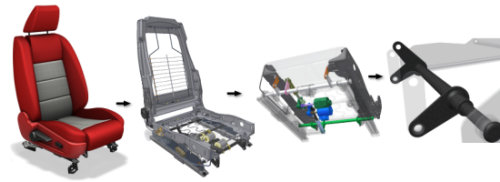
Simplify a part or assembly model. Remove low impact features or parts to improve performance with no significant effects to the final results:
Simplify models that contain a thin body. A component that comprises very thin wall bodies relative to the overall dimensions or size of the model can be thin (for example sheet metal or frame structures). Therefore, analyses of such components using solid elements based FEA demands large computational resources and can provide less accurate results.
Add Loads
Know how your product reacts to loads under normal and excessive working conditions, and build in an appropriate safety factor. Important aspects of your design include load magnitude, frequency of occurrence, distribution, and nature (static or dynamic). If you can visualize how your product responds to loads, you can control your designs better.
Apply structural loads Normal to the face where the force is perpendicular to the face. Apply structural loads Directional to the face with a magnitude specified in each direction.
Body loadsact on the entire volume or mass of a component. Examples of body loads include, but are not limited to gravitational force created through the application of linear acceleration and angular velocity and acceleration.
Specify Materials
The Inventor materials are managed with the Styles and Standards Editor. You can modify existing materials or create new ones. When you create or modify materials, be careful to assign the correct material characteristics.
Generally, materials are assigned at the Part model level in the components iProperties. There, the Physical Properties tab describes the fundamental aspects of the material. Stress analysis simulations use this information.
When you start a new part, the component material is set to whatever the document template uses. The document templates for Inventor part and assemblies use a material called Default. The Default material is not defined for use in the simulation environment. As a result, if the material for any component is assigned the Default, override the material.
- Constant All structural material properties do not change with respect to temperature and time.
- Homogeneous Material properties do not change throughout the volume of the part.
- Linear Structural Stress is directly proportional to strain.
Specify Contact Conditions
You can edit contacts at any time in the process.
Automatic Contacts Based on the settings in the Edit Simulation Properties dialog box.
Manual Contactassign manually with the command.
Address warning icons at parent browser nodes
State icons display next to parent nodes in the Stress Analysis browser to indicate a node is out-of-date, or issues exist for the child nodes. Initially, the Update Required icon ![]() displays next to the parent node. If the Warning icon
displays next to the parent node. If the Warning icon ![]() appears after the node is updated, then an issue exists for one or more child nodes.
appears after the node is updated, then an issue exists for one or more child nodes.
